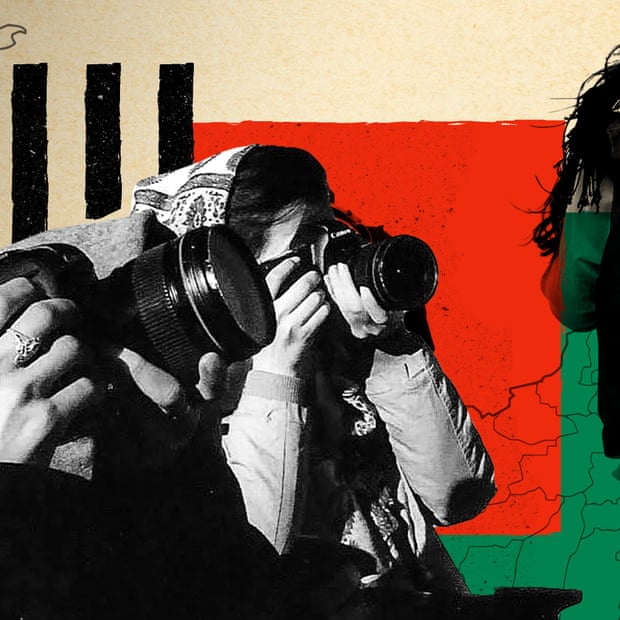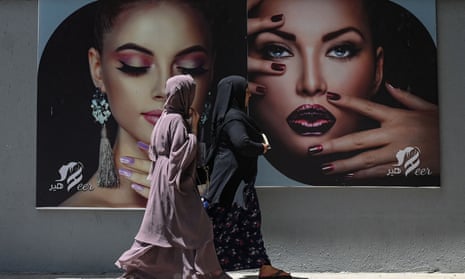In a market in Kabul, Aref is doing a booming trade. At first glance, the walls of his shop seem to be curtained in folds of blue fabric. On closer inspection, dozens and dozens of blue burqas hang like spectres from hooks on the wall.
As the Taliban close in on Kabul, women inside the city are getting ready for what may be coming. “Before, most of our customers were from the provinces,” says Aref. “Now it is city women who are buying them.”
One of these women is Aaila, who is haggling with another shopkeeper over rapidly inflating burqa prices. “Last year these burqas cost AFS 200 [£2]. Now they’re trying to sell them to us for AFS 2,000 to 3,000,” she says. As the fear among women in Kabul has grown, the prices have risen.
Q&AWhat is the Women report Afghanistan series?
Show

With Afghanistan under Taliban control, women’s voices have been silenced. For this special series, the Guardian’s Rights and freedom project has partnered with Rukhshana Media, a collective of female journalists across Afghanistan, to bring their reporting on the situation for girls and women across the country to a global audience.
Afghan journalists, especially women, face a dire situation. The free press has been obliterated by the Taliban, and female journalists have been forced to flee or have lost their jobs. Many of those still in the country are in hiding. Those who have escaped are now refugees facing an uncertain future.
All of the reporting in this series will be carried out by Afghan women, with support from the editors on the Rights and freedom project.
These are the stories that Afghan women want to tell about what is happening to their country at this critical moment.
For decades, the traditional Afghan burqa, mostly sold in shades of blue, was synonymous with Afghan women’s identity around the world. Usually made of heavy cloth, it is specifically designed to cover the wearer from head to toe. A netted fabric is placed near the eyes so that the woman inside can peer out through the meshing but nobody can see inside. It was enforced strictly during the Taliban regime in the late 1990s, and failure to wear one while in public could earn women severe punishments and public lashings from the Taliban’s “moral police”.
After the fall of the Taliban in 2001, even though many continued to choose to wear the burqa in adherence to religious and traditional beliefs, its rejection by millions of others across the country became a symbol of a new dawn for the country’s women, who were able to dictate what they wore for themselves again.
Today, there are burqas in the streets of downtown Kabul but women are also dressed in an array of different styles, many mixing traditional materials with colourful modern patterns and fashion inspiration from across the region.
“Afghan women are some of the most naturally stylish women in the world,” says Fatimah, an artist and fashion photographer. “When you go on to the streets of Kabul today you see this amazing mix of different fabrics and nods to centuries-old traditions mixed with very modern styles and inspirations. It’s this beautiful, creative spirit that was just full of hope for the future.”
Now the seemingly unstoppable advance of the Taliban has once again seen the burqa pulled out of dusty storerooms and cupboards by women who remember life under the militants’ rule.
Last week in Herat city, as Taliban forces massed around the city, older women such as 60-year-old Fawzia were out stockpiling for the younger women in her family.

Fawzia remembers the realities of living as a woman under the Taliban two decades ago.
“All of us older women have been talking about how hard it was as a woman in the old days,” she said. “I used to live in Kabul then and I remember how they beat the women and girls who left their homes without their burqas.”
Miriam, a young woman, was also out shopping after she said her husband forced her to go out to get herself a burqa. “My husband asked me to change the type of clothes I wear, and to start wearing the burqa so that the Taliban will pay less attention to me if I am outside,” she said, unhappy with the developments.
Days later, these women are already under Taliban control after Herat city fell to militant forces on Thursday. Shortly after the city fell, a Taliban declaration was circulated online and among Herat citizens informing women that wearing the burqa was now mandatory in all public spaces.
In Kabul, a sense of grief and panic has overwhelmed women in the Afghan capital. With two-thirds of the population under the age of 30, most women here have never lived under Taliban control.
In some households, the burqa has sparked divisive inter-generational conflicts. The parents of 26-year-old Habiba are begging her and her sisters to get a burqa before the Taliban enter the city, but she is resisting.
“My mother says we should buy a burqa. My parents are afraid of the Taliban. My mother thinks that one of the ways she can protect her daughters is to make them wear the burqa,” she says.
“But we have no burqa in our home, and I have no intention of getting one. I don’t want to hide behind a curtain-like cloth. If I wear the burqa, it means that I have accepted the Taliban’s government. I have given them the right to control me. Wearing a chador is the beginning of my sentence as a prisoner in my house. I’m afraid of losing the accomplishments I fought for so hard.”
Habiba is a university student, with her entire life ahead of her. Already there are reports of what the Taliban are doing to women in areas they now control: restricting their freedom of movement and seeking out those who have led public lives.
Habiba says that she, like many women in Kabul, is sick with worry over what is coming.
“I stay up late at night, sometimes till one or two in the morning, worrying about what will happen. I am afraid that because I am rejecting the burqa, soon I will have to stay at home and I will lose my independence and freedom.
“But if I accept the burqa, it will exercise power over me. I am not ready to let that happen.”
Many younger women in Kabul feel the same conflicting sense of despair and defiance. Amul, a model and designer, has worked for years to establish a small business and now she sees it heading towards obliteration.
“My whole life has been about trying to show the beauty, diversity and creativity of Afghan women,” she says. All her life, she says, she has fought the image of the Afghan woman as a faceless figure in a blue burqa. “I never thought I would wear one but now I don’t know.
“It’s like my identity is about to be scrubbed out.”
The picture caption on the first image of this article was amended on 16 August 2021 to remove a suggestion that the women walking the billboard were wearing burqas.
Now more than ever, Afghan women need a platform to speak for themselves. As the Taliban’s return haunts Afghanistan, the survival of Rukhshana Media depends on readers’ help. To continue reporting over the next crucial year, it is trying to raise $20,000. If you can help, go to this crowdfunding page.
